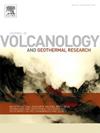On the transport of CO2 and Radon in the geothermal area of Acoculco, Puebla, Mexico
IF 2.3
3区 地球科学
Q2 GEOSCIENCES, MULTIDISCIPLINARY
Journal of Volcanology and Geothermal Research
Pub Date : 2025-09-30
DOI:10.1016/j.jvolgeores.2025.108451
引用次数: 0
Abstract
We present a conceptual and numerical description of CO and Radon (222Rn) transport in the geothermal system of Acoculco, Mexico. We build upon extensive CO flux measurements that have been conducted in the past and new CO flux and Rn concentration data collected during this investigation. The accumulation chamber method was employed for CO flux measurements, whereas Rn concentration derives from analysis of gas samples collected in active scintillation cells. Additionally, the structural setting in the study area is reinterpreted based on a geomorphological assessment. As a result, a 3D conceptual model of the CO and Rn is proposed and numerically modeled with the aid of TOUGHREACT V4. Our collected data confirm the existence of advective transport of CO and Rn within two sites known as Azufres and Alcaparrosa, with soil CO fluxes that can reach 30,000 g m−2day−1, and Rn concentrations as high as 12,000 Bq/m. In view of the relatively short half-life of 222Rn (3.8 days), the measured concentrations are indicative of localized permeable paths that connect with deep structures. Our numerical model represents adequately the non-isothermal diffusive transport of CO, while advective fluxes are not attained under simple darcian flow. Likewise, under a hypothesis of a deep Rn source (1200 m), with an initial molar ratio Rn/CO of 1, Rn concentrations drop rapidly (within 100 m from the source). Non-porous flow (channeling) and distributed sources of Rn arise as likely hypotheses to explain cold degassing in Acoculco.
CO2和氡在墨西哥普埃布拉州acococco地热区的输送
我们提出了CO2和氡(222Rn)在墨西哥acococco地热系统中传输的概念和数值描述。我们建立在过去进行的广泛的二氧化碳通量测量和在这次调查中收集的新的二氧化碳通量和Rn浓度数据的基础上。CO2通量测量采用累积室法,而Rn浓度则来自于对活跃闪烁细胞中收集的气体样品的分析。此外,在地貌评估的基础上,对研究区域的构造背景进行了重新解释。因此,提出了CO2和Rn的三维概念模型,并借助TOUGHREACT V4进行了数值模拟。我们收集的数据证实,在Azufres和Alcaparrosa两个地点存在二氧化碳和Rn的平流运输,土壤CO2通量可达到30,000 g m−2day−1,Rn浓度高达~ 12,000 Bq/m3。鉴于222Rn的半衰期相对较短(~ 3.8天),测量的浓度指示了与深部结构连接的局部渗透路径。我们的数值模型充分地反映了CO2的非等温扩散输运,而在简单的达西流下没有得到平流通量。同样,在深Rn源(~ 1200 m)的假设下,初始Rn/CO2的摩尔比为1×10−4,Rn浓度迅速下降(距离源~ 100 m内)。无孔流动(通道)和分布的Rn来源可能是解释acococco冷脱气的假设。
本文章由计算机程序翻译,如有差异,请以英文原文为准。
求助全文
约1分钟内获得全文
求助全文
来源期刊
CiteScore
5.90
自引率
13.80%
发文量
183
审稿时长
19.7 weeks
期刊介绍:
An international research journal with focus on volcanic and geothermal processes and their impact on the environment and society.
Submission of papers covering the following aspects of volcanology and geothermal research are encouraged:
(1) Geological aspects of volcanic systems: volcano stratigraphy, structure and tectonic influence; eruptive history; evolution of volcanic landforms; eruption style and progress; dispersal patterns of lava and ash; analysis of real-time eruption observations.
(2) Geochemical and petrological aspects of volcanic rocks: magma genesis and evolution; crystallization; volatile compositions, solubility, and degassing; volcanic petrography and textural analysis.
(3) Hydrology, geochemistry and measurement of volcanic and hydrothermal fluids: volcanic gas emissions; fumaroles and springs; crater lakes; hydrothermal mineralization.
(4) Geophysical aspects of volcanic systems: physical properties of volcanic rocks and magmas; heat flow studies; volcano seismology, geodesy and remote sensing.
(5) Computational modeling and experimental simulation of magmatic and hydrothermal processes: eruption dynamics; magma transport and storage; plume dynamics and ash dispersal; lava flow dynamics; hydrothermal fluid flow; thermodynamics of aqueous fluids and melts.
(6) Volcano hazard and risk research: hazard zonation methodology, development of forecasting tools; assessment techniques for vulnerability and impact.

 求助内容:
求助内容: 应助结果提醒方式:
应助结果提醒方式:


